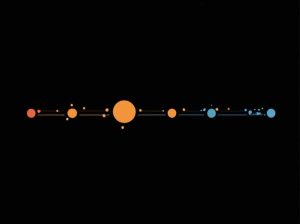When you look up at the night sky, you’ll notice that some stars shine more brightly than others. The brightness of a star depends on its size, temperature, and distance from Earth. In this topic, we’ll rank the brightest stars visible from Earth and explore what makes them shine so brilliantly.
How Is a Star’s Brightness Measured?
Astronomers measure a star’s brightness using two key factors:
1. Apparent Magnitude
This refers to how bright a star appears from Earth. The lower the magnitude number, the brighter the star. For example, a star with a magnitude of -1.46 (like Sirius) is much brighter than a star with a magnitude of 3.5.
2. Absolute Magnitude
This measures how bright a star would be if it were placed 32.6 light-years (10 parsecs) from Earth. This allows astronomers to compare stars without the effect of distance.
Now, let’s rank the brightest stars based on apparent magnitude—how bright they appear from Earth.
Top 10 Brightest Stars in the Night Sky
1. Sirius (Alpha Canis Majoris)
- Apparent Magnitude: -1.46
- Distance from Earth: 8.6 light-years
- Constellation: Canis Major
- Fun Fact: Sirius is often called the “Dog Star” and is the brightest star in the night sky. It is actually a binary system, consisting of Sirius A (a main-sequence star) and Sirius B (a white dwarf).
2. Canopus (Alpha Carinae)
- Apparent Magnitude: -0.74
- Distance from Earth: 310 light-years
- Constellation: Carina
- Fun Fact: Canopus is much farther away than Sirius, but its immense size and luminosity make it the second-brightest star visible from Earth.
3. Rigil Kentaurus (Alpha Centauri A & B)
- Apparent Magnitude: -0.27
- Distance from Earth: 4.37 light-years
- Constellation: Centaurus
- Fun Fact: Alpha Centauri is the closest star system to Earth. It consists of Alpha Centauri A, Alpha Centauri B, and the faintest member, Proxima Centauri, which is the closest star to the Sun.
4. Arcturus (Alpha Bootis)
- Apparent Magnitude: -0.05
- Distance from Earth: 36.7 light-years
- Constellation: Boötes
- Fun Fact: Arcturus is an orange giant that is nearing the end of its life. It shines 170 times brighter than the Sun.
5. Vega (Alpha Lyrae)
- Apparent Magnitude: 0.03
- Distance from Earth: 25 light-years
- Constellation: Lyra
- Fun Fact: Vega is one of the most studied stars and served as the “zero point” for the magnitude scale in the past.
6. Capella (Alpha Aurigae)
- Apparent Magnitude: 0.08
- Distance from Earth: 42 light-years
- Constellation: Auriga
- Fun Fact: Capella is actually a double star system made up of two yellow giant stars orbiting each other.
7. Rigel (Beta Orionis)
- Apparent Magnitude: 0.13
- Distance from Earth: 860 light-years
- Constellation: Orion
- Fun Fact: Rigel is a blue supergiant and one of the most luminous stars in our galaxy. Despite being named “Beta Orionis,” it is actually brighter than “Alpha Orionis” (Betelgeuse).
8. Procyon (Alpha Canis Minoris)
- Apparent Magnitude: 0.34
- Distance from Earth: 11.4 light-years
- Constellation: Canis Minor
- Fun Fact: Procyon means “Before the Dog” because it rises before Sirius in the night sky. It is a binary system with a white dwarf companion.
9. Achernar (Alpha Eridani)
- Apparent Magnitude: 0.46
- Distance from Earth: 139 light-years
- Constellation: Eridanus
- Fun Fact: Achernar is an extremely fast-rotating star, making it oblate (flattened at the poles and wider at the equator).
10. Betelgeuse (Alpha Orionis)
- Apparent Magnitude: 0.50 (variable)
- Distance from Earth: 642 light-years
- Constellation: Orion
- Fun Fact: Betelgeuse is a red supergiant nearing the end of its life. It is expected to go supernova within the next 100,000 years.
Dim Stars: The Least Luminous Stars
While the stars listed above are among the brightest, many stars are so dim that they can’t be seen without a telescope.
1. Proxima Centauri
- Apparent Magnitude: 11.13
- Distance from Earth: 4.24 light-years
- Constellation: Centaurus
- Fun Fact: Despite being the closest star to Earth (after the Sun), Proxima Centauri is a red dwarf and is too faint to be seen with the naked eye.
2. Barnard’s Star
- Apparent Magnitude: 9.51
- Distance from Earth: 5.96 light-years
- Constellation: Ophiuchus
- Fun Fact: Barnard’s Star is famous for having one of the fastest known proper motions across the sky.
3. Wolf 359
- Apparent Magnitude: 13.54
- Distance from Earth: 7.78 light-years
- Constellation: Leo
- Fun Fact: This red dwarf star is one of the dimmest and smallest known stars.
Why Do Some Stars Appear Brighter Than Others?
Several factors determine a star’s brightness as seen from Earth:
1. Distance
The closer a star is, the brighter it appears. For example, Sirius looks brighter than Canopus, even though Canopus is more luminous, because Sirius is much closer to Earth.
2. Luminosity
Some stars naturally emit more light due to their size and temperature. For example, Rigel is a blue supergiant, which makes it far more luminous than a small red dwarf like Proxima Centauri.
3. Size and Temperature
- Hotter stars (like Rigel) emit more light and appear blue or white.
- Cooler stars (like Betelgeuse) emit less light and appear red or orange.
The stars in our night sky vary greatly in brightness, depending on their size, temperature, and distance from Earth. Sirius reigns as the brightest star we can see, while Proxima Centauri and other red dwarfs remain hidden without a telescope. Understanding stellar brightness helps astronomers learn more about the structure and evolution of our universe.



